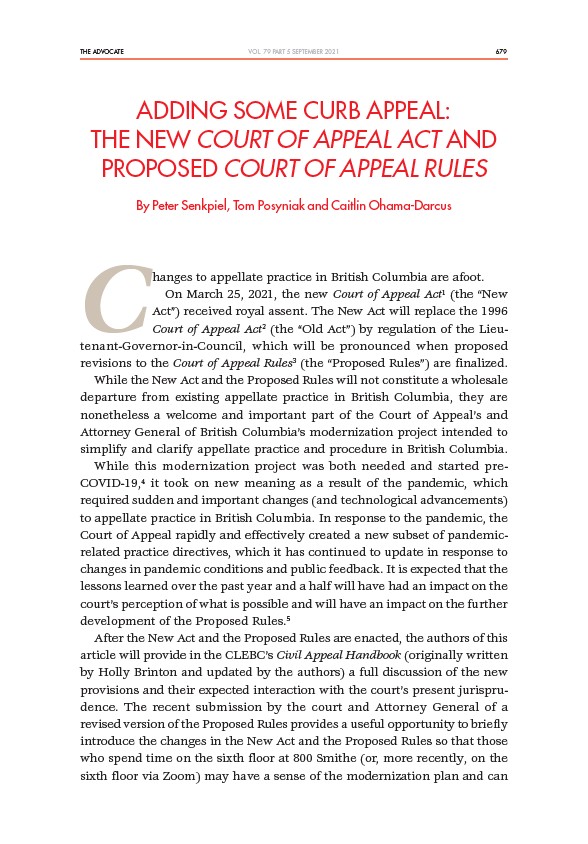
THE ADVOCATE 679
VOL. 79 PART 5 SEPTEMBER 2021
ADDING SOME CURB APPEAL:
THE NEW COURT OF APPEAL ACT AND
PROPOSED COURT OF APPEAL RULES
By Peter Senkpiel, Tom Posyniak and Caitlin Ohama-Darcus
Changes to appellate practice in British Columbia are afoot.
On March 25, 2021, the new Court of Appeal Act1 (the “New
Act”) received royal assent. The New Act will replace the 1996
Court of Appeal Act2 (the “Old Act”) by regulation of the Lieutenant
Governor-in-Council, which will be pronounced when proposed
revisions to the Court of Appeal Rules3 (the “Proposed Rules”) are finalized.
While the New Act and the Proposed Rules will not constitute a wholesale
departure from existing appellate practice in British Columbia, they are
nonetheless a welcome and important part of the Court of Appeal’s and
Attorney General of British Columbia’s modernization project intended to
simplify and clarify appellate practice and procedure in British Columbia.
While this modernization project was both needed and started pre-
COVID-19,4 it took on new meaning as a result of the pandemic, which
required sudden and important changes (and technological advancements)
to appellate practice in British Columbia. In response to the pandemic, the
Court of Appeal rapidly and effectively created a new subset of pandemicrelated
practice directives, which it has continued to update in response to
changes in pandemic conditions and public feedback. It is expected that the
lessons learned over the past year and a half will have had an impact on the
court’s perception of what is possible and will have an impact on the further
development of the Proposed Rules.5
After the New Act and the Proposed Rules are enacted, the authors of this
article will provide in the CLEBC’s Civil Appeal Handbook (originally written
by Holly Brinton and updated by the authors) a full discussion of the new
provisions and their expected interaction with the court’s present jurisprudence.
The recent submission by the court and Attorney General of a
revised version of the Proposed Rules provides a useful opportunity to briefly
introduce the changes in the New Act and the Proposed Rules so that those
who spend time on the sixth floor at 800 Smithe (or, more recently, on the
sixth floor via Zoom) may have a sense of the modernization plan and can